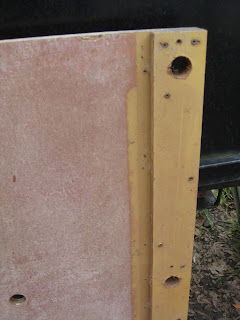The last 4 inches of the she-bolt is tapered so that when the walls are finished and the forms come off the she-bolts un screw from the all thread which is left behind inside the wall.
What is left is a 3/4" diameter hole in the wall which is easily plugged with a small amount of rammed earth mix and it virtually disappears. 3/4" coilrod: Coilrod has a course thread and comes in 12 foot lengths and is relitively inexpensive.
3 sizes of #8 square drive screws. Good screws and a good driver are key to this forming system. We get our screws from Mcfeelys: 2 7/8" promax flathead steel for screwing 2x lumber to 2x lumber, 2 1/8" promax flathead steel for screwing plywood to lumber and 1 1/4" for screwing plywood to plywood. We use these screws over and over, dozens of times.
Form-aligners, Chamfer strip, brads and electrical staples.
We start with the basic box developed by REW: opposing formfaces, endboards, pipeclamps outside the endboards carried by the formfaces through 1 1/4" holes, drilled 16" on center vertically with 2x12 walers on top of the clamps. The whole idea behind forms for rammed earth is to get everything out of the way so the tampers can easily go where they are needed and have nothing to hit. That is the beauty of the REW box; there is nothing in the way. We have added two things: 1) a 3" strip of HDO attached to the inside edge of each end of the formfaces as stops to support the endboards.
and 2) electrical staples tying the top waler to the top of the formfaces to prevent mix from getting between the walers and the forms.
A 2x12 can only span about 8 feet without any noticeable deflection. If we want to build a wall longer than 8 feet we have to add intermediate support. This is where the traditional concrete forming comes into play. We like to build our forms to full height (top of wall) so our plywood is set vertically. Our form length is limited by how much we think we can get done in a day, usually 30 to 50 feet. The plywood is held together by 3.5"x8" pieces of HDO("tablitas") attached every 16" from the top down.
These pieces not only hold the plywood together they also support the inside edge of the walers.
The top of those ends support the outside edge of the walers so their height needs to be the same height as the top of the tablitas. The top of the strongback should extend at least 12 inches above the top of the forms. The opposing strongbacks are held together by a she-bolt at the bottom going through the wall about 3'' above the concrete foundation and a coilrod about 3" above the top of the forms. If the wall height is more than 8 feet another she-bolt must be placed in the center or every 6 to 8 feet. The forms clamp onto a lip in the concrete foundation and held open by 2x4s (separators) cut to the thickness of the wall placed above the center she-bolts and at the top of the forms under each coilrod. You have to be careful to take these separators out as you approach their level when ramming. The 2x12 walers can then be inserted between the forms and the strongbacks. Make sure the walers do not sag and hang up on a tablita.
Once the forms are built they are self supporting. As they are erected form aligners need to be employed to keep them from falling over. Then when the forms are finished they can be used to line and plumb the forms.
Corners: The plywood on the inside is mitered and held together with brads, hundreds of them. The plywood on the outside is butted and held together with 2" screws every 3 to 4". The walers need to overlap at the corners, inside and outside. Four 2 7/8" screws are used at each place the walers overlap.
Chamfer strip, usually 1/2" or 3/4", is installed at all outside corners with a pneumatic brad nailer.
For spans less than 8 feet, smaller dimensional lumber can be used. The rule of thumb is a board can span 2 feet less than its width: a 2x4 can span 2 feet, a 2x6 can span 4 feet, etc.















No comments:
Post a Comment